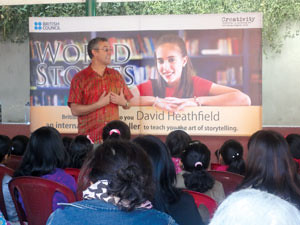British storyteller speaks on the importance of dealing with sensitive issues through indigenous storytelling traditions David Heathfield, a storyteller from the UK was invited to Nepal by the British Council to hold workshops with students and teachers on the craft of storytelling. Before he began his career as a storyteller, Heathfield used to be a teacher and understands the importance of oral communication in the classroom and the pivotal role stories play in developing the imagination. Nepali Times caught up with him recently in Kathmandu.
 SUCHITA SHRESTHA |
Nepali Times: How receptive were Nepali children to your storytelling?
David Heathfield: The children have been amazingly receptive. I conducted two story telling workshops with students at Rato Bangla School and was blown away by their level of enthusiasm and participation. I was also very impressed by their competency in English and the way they used the language to express themselves so creatively.
How do Nepali children compare to children around the world?
From what I have seen so far, Nepali children are high achievers and their accomplishment at the workshops was outstanding. We were creating stories together and they responded with a great degree of maturity and imagination. They were eager to participate, wonderfully open-hearted and were just really comfortable expressing themselves with each other, which I found very exciting. A good storyteller is able to tell stories from the heart and these children had that skill in abundance.
Nepal has a long tradition of storytelling, how do you think Nepalis can preserve this tradition in the era of digital media?
Oral storytelling which has been practiced in Nepal for generations should be the heart of education, but unfortunately it is often sidelined. The face-to-face interaction between teachers and students which you get through this kind of storytelling is a very powerful teaching and learning tool. However, teachers can still incorporate modern technology into traditional methods by recording the stories so that they remember all the details and know the story well enough to re-tell it.
How can Nepali students and teachers learn from other countries to build upon their storytelling skills?
I think it's really important to first know about stories from your own background and culture, but listening to stories from other countries is a great way to learn about their cultures. Within each story you tend to get very specific features of the culture where it comes from, which makes sharing information about traditions through storytelling a very creative way to learn. We in the west have a lot to learn from Nepali tradition. When we don't have access to computers or the internet, we can fall back on Nepali style of oral storytelling.
Do you think storytelling should be used as an indirect means of talking about sensitive issues?
Absolutely, that is one of the central objectives of storytelling. A story acts as a metaphor for sensitive issues, making it a very simple and safe way toexplore uncomfortable topics. It allows children and adults to have discussions on issues they would otherwise find hard to talk about. It's a way we can learn about how we behave, or how we should behave, and explore the darker side of human actions through the lenses of traditional tales.


